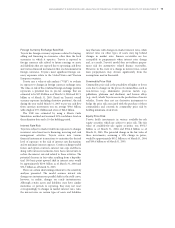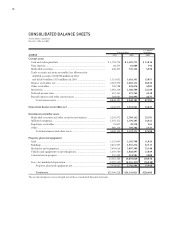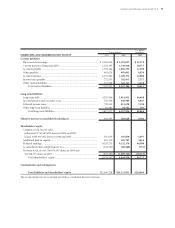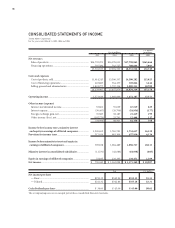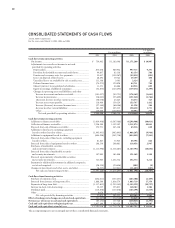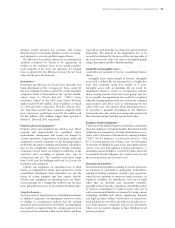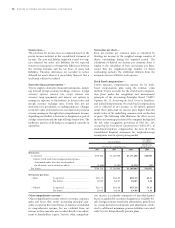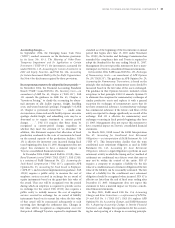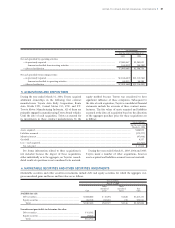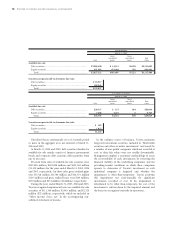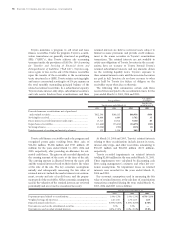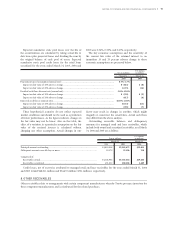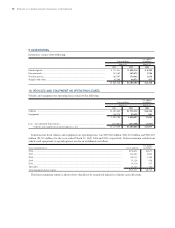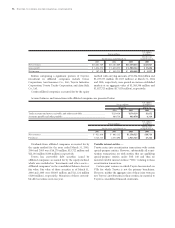Toyota 2005 Annual Report Download - page 86
Download and view the complete annual report
Please find page 86 of the 2005 Toyota annual report below. You can navigate through the pages in the report by either clicking on the pages listed below, or by using the keyword search tool below to find specific information within the annual report.
Income taxes—
The provision for income taxes is computed based on the
pretax income included in the consolidated statement of
income. The asset and liability approach is used to recog-
nize deferred tax assets and liabilities for the expected
future tax consequences of temporary differences between
the carrying amounts and the tax bases of assets and
liabilities. Valuation allowances are recorded to reduce
deferred tax assets when it is more likely than not that a
tax benefit will not be realized.
Derivative financial instruments—
Toyota employs derivative financial instruments, includ-
ing forward foreign currency exchange contracts, foreign
currency options, interest rate swaps, interest rate
currency swap agreements and interest rate options to
manage its exposure to fluctuations in interest rates and
foreign currency exchange rates. Toyota does not use
derivatives for speculation or trading purposes. Changes
in the fair value of derivatives are recorded each period in
current earnings or through other comprehensive income,
depending on whether a derivative is designated as part of
a hedge transaction and the type of hedge transaction. The
ineffective portion of all hedges is recognized currently in
operations.
Net income per share—
Basic net income per common share is calculated by
dividing net income by the weighted-average number of
shares outstanding during the reported period. The
calculation of diluted net income per common share is
similar to the calculation of basic net income per share,
except that the weighted-average number of shares
outstanding includes the additional dilution from the
assumed exercise of dilutive stock options.
Stock-based compensation—
Toyota measures compensation expense for its stock-
based compensation plan using the intrinsic value
method. Toyota accounts for the stock-based compensa-
tion plans under the recognition and measurement
principles of the Accounting Principles Board (“APB”)
Opinion No. 25, Accounting for Stock Issued to Employees,
and related Interpretations. No stock-based compensation
cost is reflected in net income, as all options granted
under those plans had an exercise price higher than the
market value of the underlying common stock on the date
of grant. The following table illustrates the effect on net
income and earnings per share if the company had applied
the fair value recognition provisions of FAS No. 123,
Accounting for Stock-Based Compensation (“FAS 123”), to
stock-based employee compensation. See note 18 to the
consolidated financial statements for weighted-average
assumptions used in option pricing model.
84 >NOTES TO CONSOLIDATED FINANCIAL STATEMENTS
U.S. dollars
Yen in millions in millions
For the year
For the years ended March 31, ended March 31,
2003 2004 2005 2005
Net income
As reported..................................................................................... ¥750,942 ¥1,162,098 ¥1,171,260 $10,907
Deduct: Total stock-based compensation expenses
determined under fair value based method
for all awards, net of related tax effects .................................. (1,406) (1,292) (1,571) (15)
Pro forma ....................................................................................... ¥749,536 ¥1,160,806 ¥1,169,689 $10,892
Net income per share
—Basic As reported............................................. ¥211.32 ¥342.90 ¥355.35 $3.31
Pro forma ............................................... 210.92 342.51 354.87 3.30
—Diluted As reported ............................................. ¥211.32 ¥342.86 ¥355.28 $3.31
Pro forma ............................................... 210.92 342.48 354.80 3.30
Other comprehensive income—
Other comprehensive income refers to revenues, expenses,
gains and losses that, under accounting principles gen-
erally accepted in the United States of America are included
in comprehensive income, but are excluded from net
income as these amounts are recorded directly as an adjust-
ment to shareholders’ equity. Toyota’s other comprehen-
sive income is primarily comprised of unrealized gains/
losses on marketable securities designated as available-for-
sale, foreign currency translation adjustments, gains/losses
on certain derivative instruments and adjustments attrib-
uted to additional minimum pension liabilities associated
with Toyota’s defined benefit pension plans.



